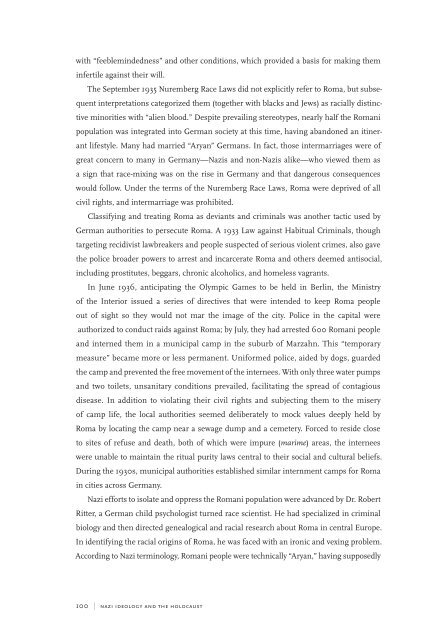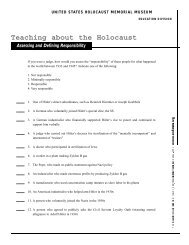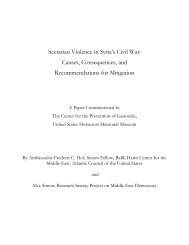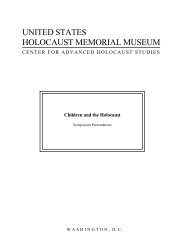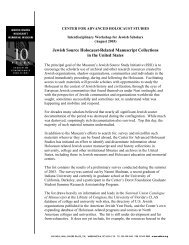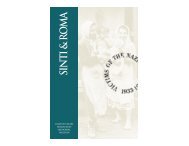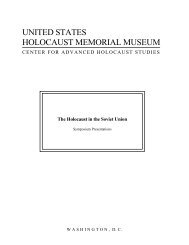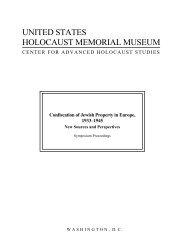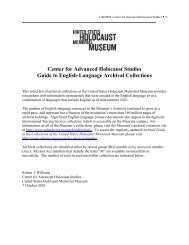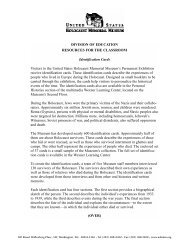the quest for racial purity - United States Holocaust Memorial Museum
the quest for racial purity - United States Holocaust Memorial Museum
the quest for racial purity - United States Holocaust Memorial Museum
Create successful ePaper yourself
Turn your PDF publications into a flip-book with our unique Google optimized e-Paper software.
with “feeblemindedness” and o<strong>the</strong>r conditions, which provided a basis <strong>for</strong> making <strong>the</strong>m<br />
infertile against <strong>the</strong>ir will.<br />
The September 1935 Nuremberg Race Laws did not explicitly refer to Roma, but subse-<br />
quent interpretations categorized <strong>the</strong>m (toge<strong>the</strong>r with blacks and Jews) as <strong>racial</strong>ly distinc-<br />
tive minorities with “alien blood.” Despite prevailing stereotypes, nearly half <strong>the</strong> Romani<br />
population was integrated into German society at this time, having abandoned an itiner-<br />
ant lifestyle. Many had married “Aryan” Germans. In fact, those intermarriages were of<br />
great concern to many in Germany—Nazis and non-Nazis alike—who viewed <strong>the</strong>m as<br />
a sign that race-mixing was on <strong>the</strong> rise in Germany and that dangerous consequences<br />
would follow. Under <strong>the</strong> terms of <strong>the</strong> Nuremberg Race Laws, Roma were deprived of all<br />
civil rights, and intermarriage was prohibited.<br />
Classifying and treating Roma as deviants and criminals was ano<strong>the</strong>r tactic used by<br />
German authorities to persecute Roma. A 1933 Law against Habitual Criminals, though<br />
targeting recidivist lawbreakers and people suspected of serious violent crimes, also gave<br />
<strong>the</strong> police broader powers to arrest and incarcerate Roma and o<strong>the</strong>rs deemed antisocial,<br />
including prostitutes, beggars, chronic alcoholics, and homeless vagrants.<br />
In June 1936, anticipating <strong>the</strong> Olympic Games to be held in Berlin, <strong>the</strong> Ministry<br />
of <strong>the</strong> Interior issued a series of directives that were intended to keep Roma people<br />
out of sight so <strong>the</strong>y would not mar <strong>the</strong> image of <strong>the</strong> city. Police in <strong>the</strong> capital were<br />
authorized to conduct raids against Roma; by July, <strong>the</strong>y had arrested 600 Romani people<br />
and interned <strong>the</strong>m in a municipal camp in <strong>the</strong> suburb of Marzahn. This “temporary<br />
measure” became more or less permanent. Uni<strong>for</strong>med police, aided by dogs, guarded<br />
<strong>the</strong> camp and prevented <strong>the</strong> free movement of <strong>the</strong> internees. With only three water pumps<br />
and two toilets, unsanitary conditions prevailed, facilitating <strong>the</strong> spread of contagious<br />
disease. In addition to violating <strong>the</strong>ir civil rights and subjecting <strong>the</strong>m to <strong>the</strong> misery<br />
of camp life, <strong>the</strong> local authorities seemed deliberately to mock values deeply held by<br />
Roma by locating <strong>the</strong> camp near a sewage dump and a cemetery. Forced to reside close<br />
to sites of refuse and death, both of which were impure (marime) areas, <strong>the</strong> internees<br />
were unable to maintain <strong>the</strong> ritual <strong>purity</strong> laws central to <strong>the</strong>ir social and cultural beliefs.<br />
During <strong>the</strong> 1930s, municipal authorities established similar internment camps <strong>for</strong> Roma<br />
in cities across Germany.<br />
Nazi ef<strong>for</strong>ts to isolate and oppress <strong>the</strong> Romani population were advanced by Dr. Robert<br />
Ritter, a German child psychologist turned race scientist. He had specialized in criminal<br />
biology and <strong>the</strong>n directed genealogical and <strong>racial</strong> research about Roma in central Europe.<br />
In identifying <strong>the</strong> <strong>racial</strong> origins of Roma, he was faced with an ironic and vexing problem.<br />
According to Nazi terminology, Romani people were technically “Aryan,” having supposedly<br />
100 | nazi ideology and <strong>the</strong> holocaust


